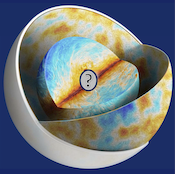Orateurs
Description
Clusters of galaxies, formed at the latest stages of structure formation, constitute unique cosmological probes and are sensitive to cosmological parameters related to structure formation like the rms of matter fluctuations. With the advent of large CMB surveys like those from the Planck satellite, the ACT and SPT telescopes, we now have access to large catalogs of galaxy clusters detected at millimeter wavelength via the thermal Sunyaev-Zeldovich (tSZ) effect. However, they do not offer the high angular resolution needed to resolve and/or detect the lowest mass, high redshift clusters. This can be achieved by using millimeter cameras operated in large millimeter telescopes, like the NIKA2 camera installed in the IRAM 30–m telescope in Pico Veleta, Spain. Combining a 6.5 arcmin diameter field of view and sub-arcminute (17.6’’ at 150 GHz) angular resolution, NIKA2 is capable of resolving the SZ effect towards clusters up to high redshifts.
In this talk, I will highlight NIKA2’s capabilities for SZ clusters studies. I will focus on the blind detection of galaxy clusters in the COSMOS field using the NIKA2 Cosmological Legacy Survey (N2CLS) Large Program observations. I will describe the candidate cluster sample we have obtained, and discuss its properties.
I will demonstrate that NIKA2 and the IRAM 30–m telescope are sensitive to the lowest mass clusters at intermediate and high redshift.

